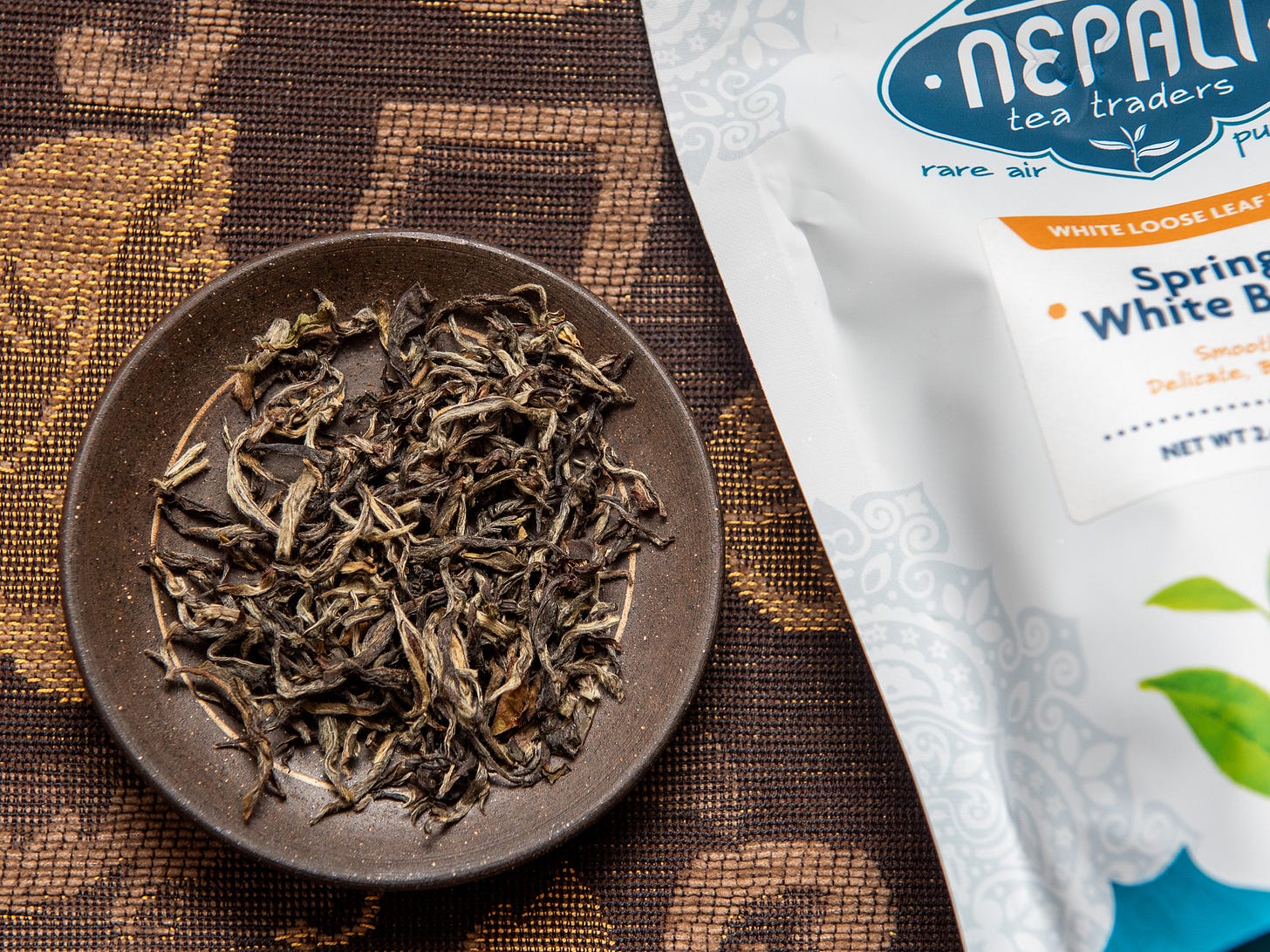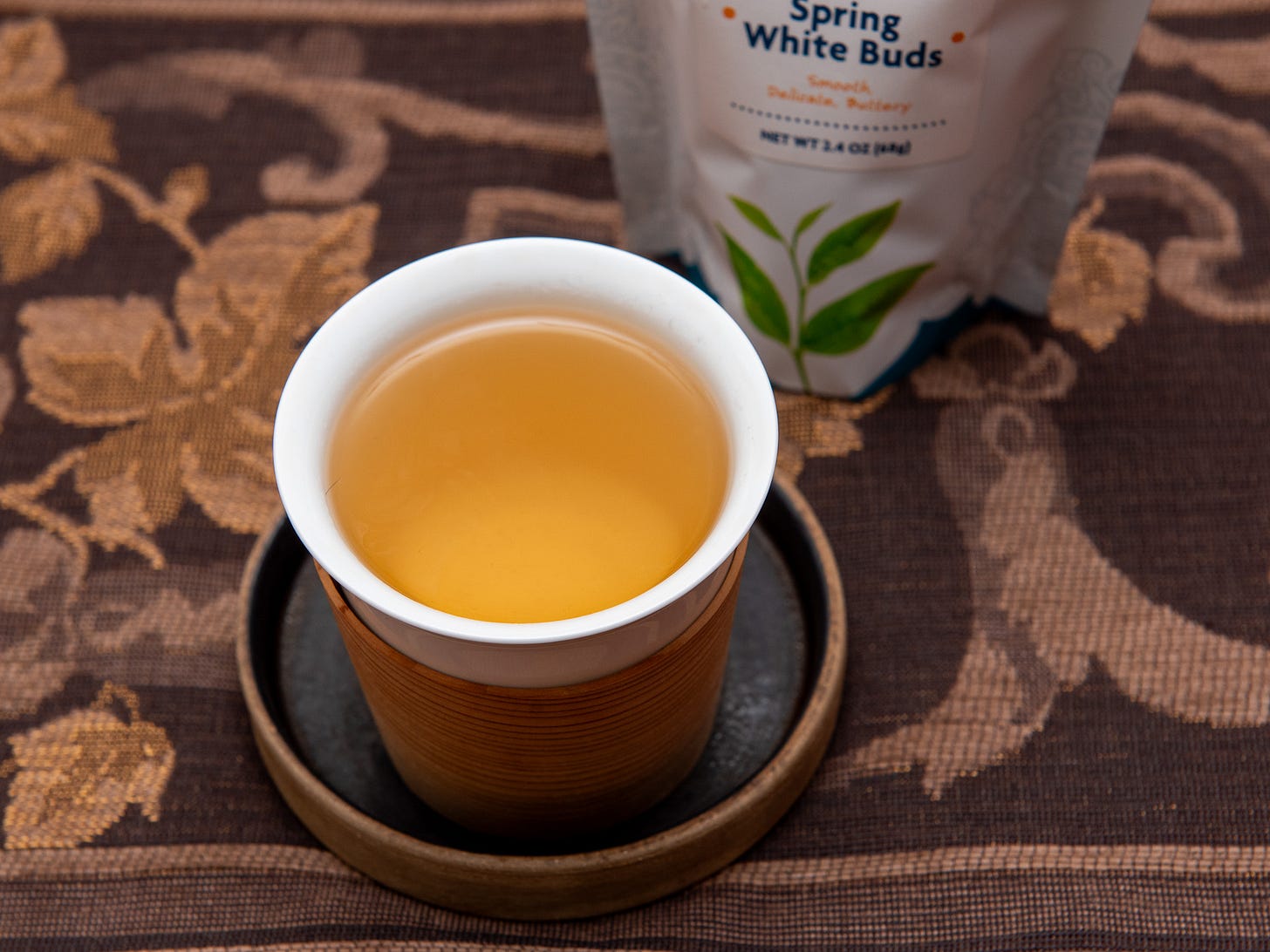Why don‘t fruit flavored teas taste like fruit?
White tea from Nepal + the difference between blending, scenting, and flavoring.
Butter-free butter tea
The tea: Spring white buds, sold by Nepali Tea Traders. $18 for 1.2oz.
Up until 20 years ago, Nepal was never well known for its tea. Most tea was commodity fare destined for domestic consumption or trade with India. Some from the eastern Ilam district was smuggled through the Indian border to be resold as pricier tea from neighboring Darjeeling. But a specialty industry has emerged in recent decades that’s worth paying attention to. Here’s a story of mine in the New York Times as to why. Since there’s no longstanding specialty tradition in Nepal, anything goes, and producers have gotten inventive with teas that draw on Chinese, Japanese, and Indian techniques.
This white tea is one of my favorites: buttered popcorn alchemically transformed into tea leaves with a crisp, airy rejoinder that seems to embody the high elevation climate the tea is grown in. Some white teas are intensely floral. Others are almost as vegetal as green tea. This one aligns with the creaminess of well cooked butter beans. It’s delicate, but with something substantial beneath. The soothing brew puts a surprising weight on your tongue, and it’s especially enjoyable to taste once the actual tea is gone and your mouth is left with a creamy afterglow. Drinking good tea should be more than a quickie. It should leave you with something.
The source: Unlike in Darjeeling, where factories own sprawling estates and hire armies of workers to pick and process leaves, many specialty producers in Nepal operate on coop models, where small farmers with their own plots of land pool plucked leaves together to increase their selling power. A local factory then buys their leaves to produce a finished tea. The farmers may or may not have financial stakes in the factory’s sales as well. Nepali Tea Traders works with such coops and factories to source their teas. Sumita Karmacharya Joshi and Rabin Joshi bought the company from founder Maggie le Beau in 2021, making it one of the few American purveyors of Nepali tea that’s owned outright by people from the region. In addition to the spring white buds, Nepali Tea Traders carries several black teas worth your attention, especially if you enjoy the deep cocoa notes of some Chinese styles.
To brew: White teas do well with a light touch—you don’t need a lot of leaf or steeping time to get a full flavored cup. I’ve settled on 2 grams in a 150 milliliter pot (1g/75ml) brewed for 60 to 90 seconds. A lot of steeping instructions tell you to use lower temperature water when making white tea, and you can do that, but I think you get a more interesting cup with full boiling water. My concession to the lower temperature brigade is to steep with the teapot lid off, which helps the water cool slightly. I get three good steeps from the spring white buds. The cup pictured above is wrapped in a collar of cryptomeria cedar wood. I like the subtle incense aromatics it lends to the tea, a practice I’m borrowing from the cedar cups used to serve sake in Japan.
Ask a Tea Person: What’s up with fruit flavored teas?
Today’s deep dive is the next installment of Ask a Tea Person, Leafhopper’s tea advice column. Check out the debut edition here, and submit your own questions by emailing max.falkowitz@gmail.com with “Ask a Tea Person” in the subject line.
I love my chai and cinnamon-y teas. Why am I always disappointed by fruit flavored teas? I never taste fruit flavors in them. — Jodi W.
Thanks for this question, Jodi, because it gives me an opportunity to distinguish between three key practices that often get muddled together: blending, scenting, and flavoring.
Keep reading with a 7-day free trial
Subscribe to Leafhopper to keep reading this post and get 7 days of free access to the full post archives.





